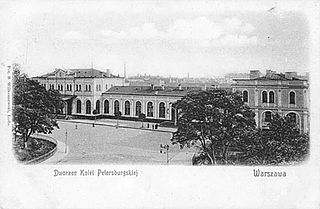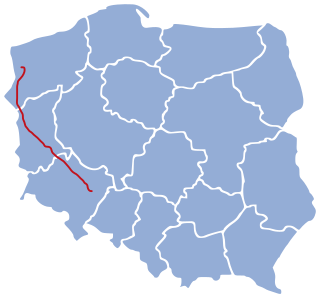Transport in Poland involves air, water, road and rail transportation. The country has a large network of municipal public transport, such as buses, trams and the metro. As a country located at the 'cross-roads' of Europe, Poland is a nation with a large and increasingly modern network of transport infrastructure.

ProRail is a Dutch government organisation responsible for the maintenance and extension of the national railway network infrastructure, the allocation of rail capacity, and controlling rail traffic. Prorail is a part of NS Railinfratrust, the Dutch railway infrastructure owner.

Alwernia is a town situated some 36 kilometres west of Kraków in the Chrzanów County, Lesser Poland Voivodeship, Poland. The town has an area of 8.88 square kilometres, and as of June 2022 it has a population of 3,284.

The Polish State Railways is the dominant railway operator in Poland. The company was founded when the former Polish State Railways state-owned enterprise was divided into several units based on the need for separation between infrastructure management and transport operations. Polish State Railways is the dominant company in PKP Group collective that resulted from the split, and maintains in 100% share control, being fully responsible for the assets of all of the other PKP Group component companies. The group's organisations are dependent upon Polish State Railways, but proposals for privatisation have been made.

The European Train Control System (ETCS) is a train protection system designed to replace the many incompatible systems used by European railways, and railways outside of Europe. ETCS is the signalling and control component of the European Rail Traffic Management System (ERTMS).

The PKP Group is a Polish corporate group founded in 2001, from the former state enterprise, Polish State Railways. The purpose of this change was to separate infrastructure management and transport operations.

PKP Intercity is a company of the PKP Group responsible for long-distance passenger transport. It runs about 350 trains daily, connecting mainly large agglomerations and smaller towns in Poland. The company also provides most international trains to and from Poland. Trains offer Wi-Fi connectivity.

PKP Cargo is a logistics operator and a part of the PKP Group in Poland. It is the largest railway freight carrier in Poland and second largest in the European Union. PKP Cargo is listed on the Warsaw Stock Exchange. The company's largest shareholder is PKP S.A. with a 33,01% share.
PKP Informatyka is a company of PKP Group responsible for supplying Polish railroad operators with IT technology.

Infrabel is a Belgian government-owned public limited company. It builds, owns, maintains and upgrades the Belgian railway network, makes its capacity available to railway operator companies, and handles train traffic control.

The Polish railways network consists of around 18,510 kilometres (11,500 mi) of track as of 2019, of which 11,998 km (7,455 mi) is electrified. The national electrification system runs at 3 kV DC.
European Rail Infrastructure Managers (EIM) is a sector association that represents the interests of European rail infrastructure managers. Members consist of owners/managers of infrastructure from most European/EEA countries.

Saint Petersburg–Warsaw Railway is a 1,333 km (828 mi) long railway, built in the 19th century by the Russian Empire to connect Russia with Central Europe. At the time the entire railway was within the Russian Empire: Warsaw was under a Russian partition of Poland. Due to territorial changes, the line now lies within five countries and crosses the eastern border of the European Union three times. Therefore, no passenger trains follow the entire route. Passenger trains between Saint Petersburg and Warsaw used to travel through Brest instead and a new line called Rail Baltica is under development to improve the direct connection between Poland and Lithuania.
Every railway line in Poland has its own number, with the lowest numbers attached to the most important and most strategic routes.
High-speed rail service commenced in Poland on 14 December 2014, with the introduction of 20 non-tilting New Pendolino trainsets operating on 4 designated lines radiating out from Warsaw. Polish State Railways started passenger service using Pendolino trains operating at a maximum speed of 200 km/h on 80 km line Olszamowice-Zawiercie. From December 2017 there are two 200 km/h sections, 136 km long in total. All high-speed services operated by PKP in Poland are branded as Express Intercity Premium (EIP).

The Grodzisk Mazowiecki–Zawiercie railway better known as the Central Rail Line, designated by Polish national railway infrastructure manager PKP Polskie Linie Kolejowe as rail line number 4, is a 224 km (139 mi) long railway line in Poland between Zawiercie outside the Katowice urban area and Grodzisk Mazowiecki in the suburbs of Warsaw.

The Warsaw–Grodzisk Mazowiecki railway is a 30 kilometer long, double-tracked, electrified suburban railway line connecting Warszawa Zachodnia station in Warsaw with Grodzisk Mazowiecki railway station in Grodzisk Mazowiecki. The line is designated by the Polish national railway infrastructure manager PKP Polskie Linie Kolejowe as rail line number 447.

The Szczecin–Świnoujście railway is a Polish 100-kilometer long railway line, connecting Szczecin with the port in Świnoujście in the West Pomeranian Voivodeship in north-western Poland, running from Szczecin Dąbie thru Goleniów, Wysoka Kamieńska, Wolin and Międzyzdroje. The line is designated as line number 401 by Polish national railway infrastructure manager PKP Polskie Linie Kolejowe. The railway is part of European TEN-T route E59 from Scandinavia to Vienna, Budapest and Prague. For this reason the classification of the PLK line is also in the "first-class" category.

The Wrocław–Szczecin railway is 356-kilometer long, double tracked, electrified railway line in Poland, connecting Wrocław with Zielona Góra, Rzepin, Kostrzyn and Szczecin.
Bane NOR SF, formerly Jernbaneverket, is the Norwegian government agency responsible for owning, maintaining, operating and developing the Norwegian railway network, including the track, stations, and the majority of other infrastructure assets.













